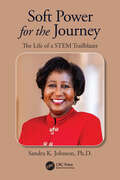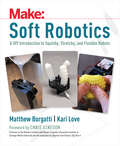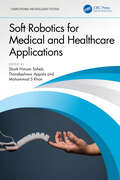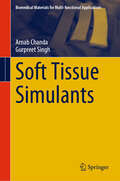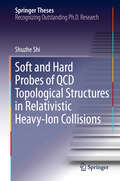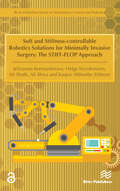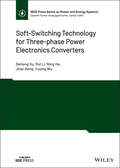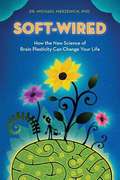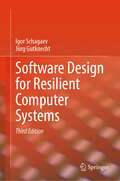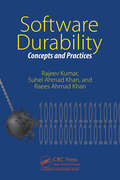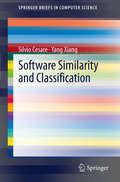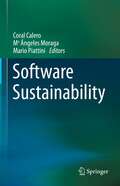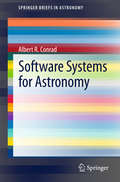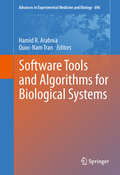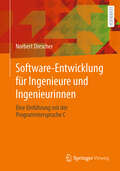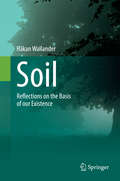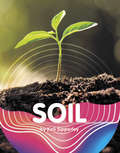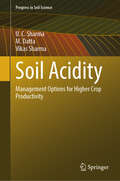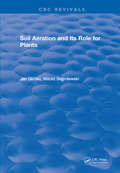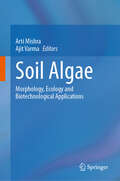- Table View
- List View
Soft Power for the Journey: The Life of a STEM Trailblazer
by Sandra K. JohnsonThis is a story of an African American woman working at the highest levels in STEM. Dr. Sandra K. Johnson earned a Ph.D. in electrical and computer engineering from Rice University, Houston, Texas, in May 1988, the first Black woman to do so. She then became a successful global technology leader and an IBM Chief Technology Officer (CTO). The story narrates the inextricable human dimension of dealing with various personal and familial challenges that people naturally encounter—with the highs and lows, and exhilarations and disappointments. It portrays her inner strength, persistence, dedication, boldness, quiet resilience, wisdom and strong faith, this soft power she leverages throughout her life. It is a heartwarming, compelling story designed to encourage, be aspirational and awe-inspiring, and uplift the spirits of a broad and diverse readership.From tragically losing her father at the age of two, to being raised by a single mother of four children, Sandra showed promise in math and science, and discipline and unrelenting drive at a young age. Raised in the deep South, she exhibited leadership even while in kindergarten and blazed trails in leadership while in junior high and high schools. Her early education was in segregated schools, with integration coming to her hometown as she started the 5th grade. Dr. Johnson’s innate abilities led her to a summer engineering program for high school students, then on to college and graduate school.Dr. Johnson has made innovative contributions in high performance computing – supercomputers – and other areas of computer engineering. She has dozens of technical publications, over 45 pending and issued patents, and a plethora of recognition and honors in her field. The book is a fascinating and intriguing story that conveys in captivating and relatable ways the remarkable life arc of a resilient person from an underprivileged background who persistently overcomes whatever odds and challenges are encountered in her life. It is a riveting human tale of a triumphant spirit, moving forward with soft power to celebrate achievement and handle obstacles with steel willpower, influential support, and faith.Access the authors' webpage here https://softpowerforthejourney.com/
Soft Robotics
by Matthew Borgatti Kari LoveSoft robotics is an emerging field that approaches robots in new ways, enabling them to operate in environments that are unstructured or unstable and to perform tasks that require delicacy and malleability. It's all about engineering with soft materials -- silicone, cloth, balloons, flexible plastics -- and combining them in different ways to come up with novel, approachable, and surprising solutions to interesting problems. This book introduces soft-robotics concepts to students, inventors, and makers with easy-to-understand explanations and hands-on DIY projects. The projects use a wide range of tools and techniques -- including microcontrollers, 3D printing, laser cutting, mold making, casting, and heat sealing -- to create intriguing soft robots and devices. It is tinkering at its finest! Code samples can be found at github.com/gianteye/makesoftrobots.World's first DIY project book on soft roboticsWritten by designers working on the forefront of the fieldApproaches projects from simple introductions to more complex designs that build on what you knowExplore robotics using novel materials and techniques you can apply to challenges far outside of roboticsSoft robotics DIY projects that are relatively affordable, accessible and achievable.Explore and build creations from the brand new emerging field of roboticsProvides context on the field of soft robotics alongside hands-on learningTeaches skills frequently overlookedProjects that are aesthetically appealing and novelForeword by Chris Atkeson, whose research directly inspired the design of Big Hero 6's Baymax
Soft Robotics for Medical and Healthcare Applications (Computational and Intelligent Systems)
by Shaik Himam Saheb Tharakeshwar Appala Mohammad S KhanSoft robotics is an emerging field that involves the development and application of robots and robotic systems made from soft and flexible materials. Soft Robotics for Medical and Healthcare Applications discusses the use of soft robotics in minimally invasive vascular surgery, for clubfoot, and filariasis leg.The title: Discusses soft robot design which is helpful for researchers and students to design the mechanisms for problems like filariasis leg, and personalized rehabilitation devices Covers metal additive manufacturing processes used for soft robot parts printing Explains design, actuation, manufacturing, and analysis of soft robots for healthcare applications Explores 3D and 4D printing for soft robotics, data-driven soft robotics, and the use of soft robotics in drug delivery Presents case studies including the creation of custom filariasis limbs and the application of soft robots in minimally invasive vascular surgery The text is primarily written for senior undergraduates, graduate students, and academic researchers in fields including electrical engineering, electronics and communications engineering, computer engineering, and biomedical engineering.
Soft Skills to Advance Your Developer Career: Actionable Steps to Help Maximize Your Potential
by Zsolt NagyAs a software developer, your technical skill set is in high demand. Devices and technology have become an integral part of our everyday lives and no digital organization can thrive without technical professionals on the payroll. However, career plateaus are inevitable in even the most high-demand field. Companies do not only need software developers; they need software developers with soft skills.In Soft Skills to Advance Your Developer Career, author Zsolt Nagy explores how emotional intelligence can give your software development career an edge. These subjects are not taught in school, and unfortunately the career advancement of many excellent developers can be blocked by their inability to effectively communicate their needs, assert themselves, and negotiate confidently. Throughout this book, Nagy shows you how to actively improve and prioritize your soft skills so that you can better represent the holistic interests of your team, obtain better working conditions, negotiate raises, and increase your variety of employment options by elevating your interviewing skills.Discover the obstacles standing between you and a fulfilling career by finding and improving strengths you may not have even known you had. Jump out of your box with Soft Skills to Advance Your Developer Career and leverage your expertise with effortless confidence at all stages of your professional journey.What You Will LearnExamine why software developer careers cannot be treated similarly as any other career pathUnderstand the four soft-skills you need to advance your careerDevelop a strategy for your personal brand and align it with your career planRealize the role of assertive communication, and the importance of giving and receiving feedbackCreate a plan for setting yourself up for a raise or promotionDiscover techniques for acing the behavioral and coding interview Who This Book Is ForSoftware developers who have the technical skills required for career advancement, but want a guide on how to manage their careers
Soft Tissue Simulants (Biomedical Materials for Multi-functional Applications)
by Gurpreet Singh Arnab ChandaSoft tissue simulants, essential for automotive and ballistic testing, medical, and surgical training, have traditionally relied on cadavers and animal tissues. However, their biomechanical properties change with time due to dehydration after death and the biomechanics of the animal models cannot be translated and compared with the human tissues. This book compiles various synthetic tissues used in these applications, addressing their characterization and industry-wide applications. While older simulants lack biofidelity, recent advancements in biofidelic soft tissue simulants offer promising alternatives, yet technology transfer remains limited. This book fills the gap by exploring each simulant's characteristics and current trends, facilitating their adoption in clinical and academic settings. These synthetic tissues have the potential to replace live tissues in surgical training, streamlining biosafety approvals. They also benefit academic researchers by reducing costs and time in biomechanical testing. Anticipated to be the first of its kind, this comprehensive reference book will showcase recent advancements in soft tissue simulant development, serving as a cornerstone text in tissue engineering & biomedical engineering, medical simulation, biomechanics, and related fields.
Soft X-Rays and Extreme Ultraviolet Radiation
by David AttwoodThis detailed, comprehensive book describes the fundamental properties of soft X-rays and extreme ultraviolet (EUV) radiation and discusses their applications in a wide variety of fields, including EUV lithography for semiconductor chip manufacture and soft X-ray biomicroscopy. The author begins by presenting the relevant basic principles such as radiation and scattering, wave propagation, diffraction, and coherence. He then goes on to examine a broad range of phenomena and applications. The topics covered include spectromicroscopy, EUV astronomy, synchrotron radiation, and soft X-ray lasers. The author also provides a wealth of useful reference material such as electron binding energies, characteristic emission lines and photo-absorption cross-sections. The book will be of great interest to graduate students and researchers in engineering, physics, chemistry, and the life sciences. It will also appeal to practising engineers involved in semiconductor fabrication and materials science.
Soft and Hard Probes of QCD Topological Structures in Relativistic Heavy-Ion Collisions (Springer Theses)
by Shuzhe ShiThis thesis makes significant advances in the quantitative understanding of two intrinsically linked yet technically very different phenomena in quantum chromodynamics (QCD). Firstly, the thesis investigates the soft probe of strong interaction topological fluctuations in the quark-gluon plasma (QGP) which is made possible via the anomalous chiral transport effects induced by such fluctuations. Here, the author makes contributions towards establishing the first comprehensive tool for quantitative prediction of the chiral magnetic effect in the QGP that is produced in heavy ion collision experiments. Secondly, the thesis deals with the hard probe of strongly coupled QGP created in heavy-ion collisions. In particular, this study addresses the basic question related to the nonperturbative color structure in the QGP via jet energy loss observables. The author further develops the CUJET computational model for jet quenching and uses it to analyze the topological degrees of freedom in quark-gluon plasma. The contributions this thesis makes towards these highly-challenging problems have already generated widespread impacts in the field of quark-gluon plasma and high-energy nuclear collisions.
Soft and Stiffness-controllable Robotics Solutions for Minimally Invasive Surgery: The STIFF-FLOP Approach (River Publishers Series In Automation, Control And Robotics Ser.)
by Kaspar Althoefer Jelizaveta Konstantinova Helge Wurdemann Ali Shafti Ali ShivaSoft and Stiffness-controllable Robotics Solutions for Minimally Invasive Surgery presents the results of a research project, funded by European Commission, STIFF-FLOP: STIFFness controllable Flexible and Learn-able manipulator for surgical Operations. In Minimally Invasive Surgery (MIS), tools go through narrow openings and manipulate soft organs that can move, deform, or change stiffness. There are limitations on modern laparoscopic and robot-assisted surgical systems due to restricted access through Trocar ports, lack of haptic feedback, and difficulties with rigid robot tools operating inside a confined space filled with organs. Also, many control algorithms suffer from stability problems in the presence of unexpected conditions. Yet biological "manipulators", like the octopus arm can manipulate objects while controlling the stiffness of selected body parts and being inherently compliant when interacting with objects. STIFF-FLOP robot is an innovative soft robotic arm that can squeeze through a standard MIS, reconfigure itself and stiffen by hydrostatic actuation to perform compliant force control tasks while facing unexpected situations. Technical topics discussed in the book include:Soft actuatorsContinuum soft manipulatorsControl, kinematics and navigation of continuum manipulatorsOptical sensors for force, torque, and curvatureHaptic feedback and human interface for surgical systemsValidation of soft stiffness controllable robots
Soft-Matter Characterization
by Robert Pecora Redouane BorsaliThis 2-volume set includes extensive discussions of scattering techniques (light, neutron and X-ray) and related fluctuation and grating techniques that are at the forefront of this field. Most of the scattering techniques are Fourier space techniques. Recent advances have seen the development of powerful direct imaging methods such as atomic force microscopy and scanning probe microscopy. In addition, techniques that can be used to manipulate soft matter on the nanometer scale are also in rapid development. These include the scanning probe microscopy technique mentioned above as well as optical and magnetic tweezers.
Soft-Switching Technology for Three-phase Power Electronics Converters (IEEE Press Series on Power and Energy Systems)
by Rui Li Dehong Xu Ning He Jinyi Deng Yuying WuSoft-Switching Technology for Three-phase Power Electronics Converters Discover foundational and advanced topics in soft-switching technology, including ZVS three-phase conversion In Soft-Switching Technology for Three-phase Power Electronics Converters, an expert team of researchers delivers a comprehensive exploration of soft-switching three-phase converters for applications including renewable energy and distribution power systems, AC power sources, UPS, motor drives, battery chargers, and more. The authors begin with an introduction to the fundamentals of the technology, providing the basic knowledge necessary for readers to understand the following articles. The book goes on to discuss three-phase rectifiers and three-phase grid inverters. It offers prototypes and experiments of each type of technology. Finally, the authors describe the impact of silicon carbide devices on soft-switching three-phase converters, studying the improvement in efficiency and power density created via the introduction of silicon carbide devices. Throughout, the authors put a special focus on a family of zero-voltage switching (ZVS) three-phase converters and related pulse width modulation (PWM) schemes. The book also includes: A thorough introduction to soft-switching techniques, including the classification of soft-switching for three phase converter topologies, soft-switching types and a generic soft-switching pulse-width-modulation known as Edge-Aligned PWM A comprehensive exploration of classical soft-switching three-phase converters, including the switching of power semiconductor devices and DC and AC side resonance Practical discussions of ZVS space vector modulation for three-phase converters, including the three-phase converter commutation process In-depth examinations of three-phase rectifiers with compound active clamping circuits Perfect for researchers, scientists, professional engineers, and undergraduate and graduate students studying or working in power electronics, Soft-Switching Technology for Three-phase Power Electronics Converters is also a must-read resource for research and development engineers involved with the design and development of power electronics.
Soft-Wired: How the New Science of Brain Plasticity Can Change Your Life
by Michael MerzenichWhat if you had the power to change your brain for the better? In Soft-Wired, Dr. Michael Merzenich--a world authority on brain plasticity--explains how the brain rewires itself across the lifespan, and how you can take control of that process to improve your life. In addition to fascinating descriptions of how your brain has produced your unique memories, skills, quirks, and emotions, Soft-Wired offers sound advice for evaluating your brain and gives clear, specific, scientifically proven guidance for how to rejuvenate, remodel, and reshape your brain to improve it at any age.
Software Defined Radios
by Michael Timmers Sofie Pollin Liesbet Van der PerreMany and ever more mobile users wish to enjoy a variety of multimedia services, in very diverse geographical environments. The growing number of communication options within and across wireless standards is accommodating the growing volume and heterogeneity in wireless wishes. On the other hand, advancement in radio technologies opening much more flexibility, a.o. through Software Defined Radios, opens up the possibility to realize mobile devices featuring multi-mode options at low cost and interesting form factors. It is crucial to manage the new degrees of freedom opened up in radios and standards in a smart way, such that the required service is offered at satisfactory quality as efficiently as possible. Efficiency in energy consumption is clearly primordial for battery powered mobile terminals specifically, and in the context of growing ecological concerns in a broader context. Moreover, efficient usage of the spectrum is a growing prerequisite for wireless systems, and coexistence of different standards puts overall throughput at risk. The management of flexibility risks bringing about intolerable complexity and hamper the desired agility. A systematic approach, consisting of anticipative preparing for smooth operation, allows mastering this challenge. Case studies show that already today, this approach enables smart operation of radios realizing impressive efficiency gains without hampering Quality-of-Service. In the future wireless communication scenes will be able to profit form the opening of the spectrum. Even smarter and cognitive behavior will become possible and essential.
Software Design for Resilient Computer Systems
by Igor Schagaev Jürg GutknechtThis book addresses the question of how system software should be designed to account for faults, and which fault tolerance features should provide for highest reliability. With this third edition of Software Design for Resilient Computer Systems, the book is thoroughly updated to contain the newest advice regarding software resilience. With a new introductory chapter, the new edition is ideal for researchers and industry professionals. In the book, the authors first show how system software interacts with the hardware to tolerate faults. They analyze and further develop the theory of fault tolerance to understand the diverse ways to increase the reliability of a system, with special attention on the role of system software in this process. They introduce the theory of redundancy and its use for construction of a subsystem through generalised algorithm of fault tolerance (GAFT) and apply it to distributed systems. The book’s approach is applied to various hardware subsystems: different structures of RAM and processor cores and demonstrates exceptional performance reliability and energy efficiency. This third edition devotes substantial attention to system software for modern computers, including run time systems, supporting algorithms of recovery and their analysis, language aspects and ways to improve reconfigurable and parallel computing. Due to the wide-reaching nature of the content, this book applies to a host of industries and research areas, including military, aviation, intensive health care, industrial control, and space exploration.
Software Durability: Concepts and Practices
by Rajeev Kumar Suhel Ahmad Khan Raees Ahmad KhanSoftware evolution is a time-consuming and costly process due to its complex architecture. Software designers need to produce software that is effective as well as durable. Durability and effectiveness of software are the foremost priorities and challenges for developers. This book comprises real-life case studies of durability issues and their solutions that bring to light loopholes and show how to fix them, to enhance durability. Existing literature on software durability tells us that the first step is to recognise the problem. It gives information about durability, risk, estimation, knowledge, and governance based on five main characteristics: dependability, trustworthiness, usability, security, and human trust. The book serves as a complete package to get acquainted with assurance and risk management from a software durability perspective. It enhances our understanding of the concept of durability, its multi-dimensional approach, threats and their types, risk, mitigation techniques, and suggestive measures. The book reviews the emerging trends in the software development process in the context of durability concepts such as automated code reviews, coding standards, and software durability standards and their testing, cost management solutions, low-code or no-code solutions, and durability assurance.
Software Quality Assurance: A Guide for Developers and Auditors
by Howard T. SmithOf all the audit functions faced by QA, software auditing is probably the most difficult because of the need to know and understand the intricacies of the processes being audited. In addition, auditors must be familiar with and understand the implications of the international and national standards and know how to proceed when deficiencies are revealed. Howard Garston Smith is Software Quality Assurance Auditor for Pfizer, UK, and brings twenty years of expertise in software development and auditing to this incredibly detailed manual. He provides the "what to" and the "how to" of software QA auditing in a clear and practical style that guarantees effective software quality audits.
Software Similarity and Classification
by Yang Xiang Silvio CesareSoftware similarity and classification is an emerging topic with wide applications. It is applicable to the areas of malware detection, software theft detection, plagiarism detection, and software clone detection. Extracting program features, processing those features into suitable representations, and constructing distance metrics to define similarity and dissimilarity are the key methods to identify software variants, clones, derivatives, and classes of software. Software Similarity and Classification reviews the literature of those core concepts, in addition to relevant literature in each application and demonstrates that considering these applied problems as a similarity and classification problem enables techniques to be shared between areas. Additionally, the authors present in-depth case studies using the software similarity and classification techniques developed throughout the book.
Software Sustainability
by Coral Calero Mario Piattini Mª Ángeles MoragaThis book focuses on software sustainability, regarded in terms of how software is or can be developed while taking into consideration environmental, social, and economic dimensions. The sixteen chapters cover various related issues ranging from technical aspects like energy-efficient programming techniques, formal proposals related to energy efficiency measurement, patterns to build energy-efficient software, the role of developers on energy efficient software systems and tools for detecting and refactoring code smells/energy bugs; to human aspects like its impact on software sustainability or the adaptation of ACM/IEEE guidelines for student and professional education and; and an economics-driven architectural evaluation for sustainability. Also aspects as the elements of governance and management that organizations should consider when implementing, assessing and improving Green IT or the relationship between software sustainability and the Corporate Social Responsibility of software companies are included. The chapters are complemented by usage scenarios and experience reports on several domains as cloud applications, agile development or e-Health, among others. As a whole, the chapters provide a complete overview of the various issues related to sustainable software development. The target readership for this book includes CxOs, (e.g. Chief Information Officers, Chief Executive Officers, Chief Technology Officers, etc.) software developers, software managers, auditors, business owners, and quality professionals. It is also intended for students of software engineering and information systems, and software researchers who want to know the state of the art regarding software sustainability.
Software Systems for Astronomy
by Albert R. ConradThis book covers the use and development of software for astronomy. It describes the control systems used to point the telescope and operate its cameras and spectrographs, as well as the web-based tools used to plan those observations. In addition, the book also covers the analysis and archiving of astronomical data once it has been acquired. Readers will learn about existing software tools and packages, develop their own software tools, and analyze real data sets.
Software Tools and Algorithms for Biological Systems
by Hamid R. Arabnia Quoc-Nam Tran"Software Tools and Algorithms for Biological Systems" is composed of a collection of papers received in response to an announcement that was widely distributed to academicians and practitioners in the broad area of computational biology and software tools. Also, selected authors of accepted papers of BIOCOMP'09 proceedings (International Conference on Bioinformatics and Computational Biology: July 13-16, 2009; Las Vegas, Nevada, USA) were invited to submit the extended versions of their papers for evaluation.
Software-Entwicklung für Ingenieure und Ingenieurinnen: Eine Einführung mit der Programmiersprache C
by Norbert DrescherSoftwareentwicklung ist mehr als nur Programme schreiben: Die Entwicklung sicherer Programme erfordert ein systematisches Vorgehen von der Aufgabenstellung bis zum getesteten Programm. In diesem Buch wird eine Vorgehensweise beschrieben, die alle Aspekte einer Softwareentwicklung umfasst. Ausgehend von allgemeinen Grundlagen und Einführungen werden die einzelnen Entwicklungsschritte vorgestellt und durch Beispiele und Übungen vertieft. Dabei wird als Programmiersprache C benutzt, die ebenfalls schrittweise eingeführt wird, sodass der Zusammenhang zwischen Entwurf, Sprachkonzept und Programmierung deutlich wird. Abgerundet wird das Buch durch zwei Anwendungsschwerpunkte, in denen die Entwicklung von Systemprogrammen und von Programmen zur Steuerung technischer Anlagen beschrieben werden.
Soil
by Håkan WallanderHåkan Wallander is a professor in Soil Biology and the reader is guided through the fascinating world below ground. The book has a free form and the author mixes scientific facts with personal stories from active research experiences and everyday life. The main focus is to make the reader aware of the vast biodiversity that exists in the soil, and to describe the important processes provided by the soil organisms. Reflections are made on how dependent we are on living soils, and how vulnerable the soil is if managed in a wrong way. The importance of soils as carbon sinks and reflections about the possible influence of soils for taste and quality of food and wine is also covered. The book is illustrated with photographs and every picture has a legend that stands on its own. In this way the reader will have an easy way into the book, and the main aim is to gain new readers to a subject that is immensely important, but not very attractive to laypersons.
Soil (Earth Materials and Systems)
by Keli SipperleySoil covers most of the land on Earth. It feeds plants and is home to many animals. Discover why soil is an important part of nature!
Soil Acidity: Management Options for Higher Crop Productivity (Progress in Soil Science)
by Vikas Sharma U. C. Sharma M. DattaThe book on acid soils offers a thorough analysis of the degree of soil acidity at the global level, information on the biota, chemistry, and behaviour of acid soils, as well as the mechanisms by which plants tolerate soil acidity. It also offers crop management strategies that make effective use of amendments and acid soil-specific crop management practices. Crop output, forest health, and aquatic life all suffer from acidic soil. The main causes are the toxicity of aluminium (Al) and/or manganese (Mn), as well as the deficiencies of calcium (Ca), magnesium (Mg), phosphorus (P), and molybdenum (Mo), to a lesser extent. Lack of calcium affects the health and integrity of cells, which lowers agricultural yield and quality. To achieve the highest crop productivity, management options have been provided. All concerned will find this book of great assistance in solving the global food crisis in a sustainable manner.
Soil Aeration and Its Role For Plants
by GlinskiThis book is directed to the interests of workers on soil aeration. Due to the interdisciplinary nature of the subject it may also be read by researchers, teachers, and students of agronomy, soil physics, soil chemistry, soil biology, ecology, and plant physiology.
Soil Algae: Morphology, Ecology and Biotechnological Applications
by Ajit Varma Arti MishraThis book collates updated knowledge about algal species which are present in the terrestrial environment particularly in soil. Contributions in this volume covers different topics such as morphology, ecology and applications of soil algae. Ecological significance of soil algae and their biotechnological importance are the key features of this book. Algae are ubiquitous and occur in almost all terrestrial environments and in soil, they majorly belong to the member of Chlorophycophyta, Cyanochloronta, Rhodophycophyta Euglenophycophyta, and Chrysophycophyta. The role of soil algae as fertilizer and for reclaiming the saline soil is well studied. Algae in soil benefits agricultural production, increase water retention capacity, reduced soil erosion, reduction of nutrient runoff, and provides nutrients. The added algae increase soil biodiversity, organic biomass, and the total humus content of the soil, beneficial for healthy soil. These soil algae diversities also have many biotechnological and industrial importance. This book is of interest and use to researchers of phycology, molecular biology, agriculture and biotechnology and also to scientists working on soil biology, agronomy and crop research. Also, the book serves as reading material for undergraduate and graduate students of microbiology, agriculture, molecular biology, and biotechnology. Researchers from biotechnological and biofertilizers companies will also find this to be a useful read.
